Introduction
In temperate regions, grazing livestock production systems are primarily constrained, both biophysically and economically, by the amount, seasonality, and interannual variability of forage produced (Oesterheld et al., 1992; Oesterheld and Salas, 1994). In those systems, setting the stocking rate is a major managerial decision. The main goal of grazing management is to balance forage supply with livestock requirements.
Native grasslands are a significant source of feed for ruminant livestock, because direct grazing of grasses and legumes is the cheapest source. In Argentina, the flooding Pampas is a cattle producing area of 8 000 000 ha, characterized by temperate humid climate, soils with low levels of permeability, organic matter and available phosphorus (Agnusdei et al., 2001). Although an average of 25 frost events occur between May and September, both forage production and grazing take place year round.
With strong seasonality, the dominant vegetation consists of C3 . and C4 - type native winter-spring and summer-autumn grasses of the genera Stipa, Piptochaetium, Briza, Paspalum, Botriochloa, and Lolium, plus the legume Trifolium ripens (Sala et al., 1981) with daily growth rates ranging from 5 kg DM/ha (winter) to 25 kg DM/ha (summer). Over time, the productivity and livestock carrying capacity of these pastures decline, largely as a result of reduced stand vigor, the invasion of unpalatable or less productive species, overgrazing and poor soil fertility. These grasslands evolved under low grazing pressure (Oesterheld and Sala, 1990), although continued use led to their degradation (Deregibus and Cahuepé, 1983) and loss of carrying capacity due to reduction of the winter grass population (Jacobo et al., 2000).
Traditionally, sown pastures are grown on low fertility soils where their productivity can be increased markedly by plowing and fertilizing. Rather than breaking the stand, rejuvenation of forage stands is probably the most economic and practical method to improve production and quality.
Direct seeding is a technological practice originally developed and improved by AAPRESID (Spanish acronym for Argentine Association of Direct Seeding Farmers) for the production of soybean and corn crops, then adapted for herbage production, relying on fertilizer and herbicide use to optimize quantity and quality of winter forage supply, according to a technological package described as «the enhancement and rejuvenation of grass species from the soil seed bank» (Tommasone and García Oliver, 1999). Such improvement consists of creating conditions of light, temperature and humidity favorable for germination of seeds from the soil bank and establishment of seedlings with minimum weed competition (Casal, 2000; Rodríguez et al., 1998).
Due to the costs involved, enhancement makes sense only if complemented by adequate pasture budgeting to optimize its effect by setting the most appropriate stocking rate. Budgeting forage implies a systematic comparison of feed offered and demanded plus efficiency calculations as key diagnostic tools, which will allow farmers and advisors to plan and evaluate managerial decisions in a rational way. Such an objective diagnostic requires a systematic quantification of herbage productivity (above-ground net primary production, ANPP) (Stuth et al., 1993), balancing available herbage and supplemental DM intake against the requirements of different classes of cattle throughout the year. The available aerial phytomass in any pasture can be assessed using standard destructive methods, non-destructive methods or by combinations of both (Meijs, 1981; Malossini et al., 1996; Danelón et al., 2001, Smit et al., 2005).
Non-destructive methods assess indirectly by using vegetation variables that can be correlated to the amount of DM (Malossini et al., 1996; Smit et al., 2005) or to the number of rations produced (Cocimano et al., 1975). For simplicity, at farmer level the budgeting pasture method mostly used in Argentina´s humid pampas is the indirect one called «ration calculation». In this procedure the unit of measure is the «ration», which assumes that to supply «one ration» requires 10 kg herbage DM containing 77.59 MJ ME (Cocimano et al., 1975), or 88.41 MJ ME (Rosso et al., 1995), an amount known as a «cow unit»(CU). Accordingly, the energy content of one CU should be 7.76 MJ ME kg-1 DM (Cocimano et al., 1975) or 8.84 MJ ME kg-1 DM (Rosso et al., 1995), and a DM digestibility (DMD) of approximately 515 or 586 g kg-1 DM (AFRC, 1993; Rosso et al., 1995, respectively). However, the estimates available indicates that the DMD of tame ryegrass could be about 700 g kg-1 DM on average (Hidalgo et al., 1998), and range from 675 g kg-1 DM to 827 g kg-1 DM (Jaurena and Danelón, 2001), and in energy concentration from 10.21 to 12.47 MJ ME kg-1 DM. Those values suggest that the use of currently accepted value of a ration (10 kg DM) leads to a loss of 14 to 38% in the efficiency of forage utilization.
In this context, the aims of the present study were: 1) to test the hypothesis that the calculating ration approach carried out at the farmer level, does not correctly assess either the quantity or the energy density of herbage necessary to make one ration, and is less efficient than the direct method based on herbage attributes; and 2) that enhancement technology increases the winter forage supply over that of a crop of annual ryegrass.
Materials and Methods
On a farm located in the Pampas floodplain of Buenos Aires Province (S 34° 57’ 01" W 58° 38’ 04"), two winter pastures: one a nine-year old native, enhanced Italian ryegrass (RGE), and the other a crop of annual ryegrass (Lolium multiflorum Lam. cv. Tama, RGT) were compared. Both 12 ha pastures were located on an Argiudol type soil, 5.87 pH; 34.6 g kg-1 organic matter (OM) and 28.71 mg kg-1 assimilable phosphorous.
Weather conditions
According to the National Weather Service the 1,219 mm of rainfall over the experimental period was consistent with the last 12-year average 1.246 ± 344 mm, (SMN, 2008). Rainfall distribution and monthly average temperatures are shown in Figure 1.
Pastures
RGE: after natural reseeding between December 2004 and January 2005, this pasture was mechanically weeded until early February when 2.0 L ha-1 of Glyphosate (N- phosphonomethyl glycine) was applied. Emergence of the ryegrass seedlings was seen on March 5. Fractionated doses of 130 kg ha-1 of NH4NO3 (AN, 340 g kg-1N) and 80 kg ha-1 of (NH4)2 HPO4(ADP, 460 g kg-1 PO) in a granular form were applied.
RGT: This pasture was sown in March over corn stubble that had been grown by direct seeding. In early February, before sowing a chemical fallow was employed, and after sowing, the RGT received 60 kg ha-1 of ADP, 120 kg ha-1 of AN, and 70 kg ha-1 of urea. These fertilizers were applied in a granular form and placed in the seed row banded away from the seed when the stands were being established.
The RGE was grazed 205 d, in eight cycles from April 23rd through November 14th and RGT 187 d in six cycles from May 5th through the end of November.
Grazing management and animal characteristics:
For both RGE and RGT, forage budgeting and balance relied on ration calculation, estimating the ANPP biomass in relation to the target efficiency of grazing (70 %).
Grazing was by the hour, in strip paddocks divided by electrified wire. The average stocking rate was 6,524 kg ha-1 . The size of strips was adjusted according to above-ground herbage availability (kg DM ha-1 ), establishing an average individual herbage allowance of 11 kg DM per half day, throughout the experimental period.
Grazing was carried out with two herds (R1 and R2) of milking cows, and one of dry cows (DC). The R1 consisted of 139 ± 2.6 cows of average live weight (LW) 606 ± 6 kg, producing 27.5 ± 2.88 L/d of milk. The R2 was composed of 121 ± 1.4 animals of 620 kg LW, producing 22.5 ± 1.76 L/d of milk. Both pastures (RGE and RGT) were always grazed after pm milking in a complementary way, i.e. once R1 grazed the last strip of the RGE, it moved to the first strip of RGT and R2 vice versa.
The R1 and R2 diets consisted of grazed herbage (RGE or RGT) and a total mixed ration (TMR) of corn silage, wheat bran, brewer’s wet grains, ground corn, whole cottonseed, and a protein concentrate (ProteoPass) at a daily rate of 13.0 ± 0.22 kg DM (R1) and 8.9 ± 0.14 kg DM (R2) equivalent to 2.1 and 1.4% of LW respectively. The TMR composition is shown in Table 1.
Pasture determinations:
The harvested aerial biomass of each plot was sampled by cutting at 3 cm above ground, 10 or more samples ha-1 with a 0.25 m2 quadrat at randomly selected points. Each sample was separated into ryegrass, white clover and weeds, each fraction was weighed fresh and then oven dried 48h at 60ºC to determine its DM content. Dry plant material was milled (Wiley-type mill with 1 mm screen) and a representative subsample kept for determination of chemical composition.
Sampling was done after noon, before and after grazing, at the beginning, middle and end of each grazing cycle. Dry matter intake (DMI) and efficiency of harvesting were estimated in both pastures at each sampling date, through the difference between initial and final herbage DM available (IHA and FHA respectively) (Meijs, 1981). Since this methodology does not account for losses of herbage due to grazing (trampling, feces, urine, etc.), and erroneously assumes that all missing biomass (IHA-FHA) represents the pasture DMI, this estimate was corrected for losses due to the accumulation of feces, transit damage caused by the mixer machine and for some TMR lost on the ground. Daily herbage productivity (kg DM/ha) was estimated as the sum of positive differences between two successive measurements of live and dead material per unit of time (Singh et al., 1975). The accumulation of grass aerial biomass in each pasture was determined at the end of the experimental period, complemented by analysis of quality (Danelón et al., 2005). Ryegrass DMD was estimated as DMD (%) = 118.3 - (1.63 x % ADF), r = 0.88, and that of white clover, as DMD (%) = 91.9 - (0.97 x % ADF), r = 0.96. Finally, the metabolizable energy content (Mcal ME/kg DM) of both components was estimated following the AFRC (1993) recommendation.

Ration Calculation:
To calculate the number of rations produced per pasture, it was necessary to establish the relationship between CU and the amount of herbage (or energy) required per CE. The number of CE equals the daily energy requirements due to (maintenance, including 30% voluntary activity plus production (AFRC, 1993; NRC 2001) divided by the energy value of one CU, i.e.: N° CE = (MJ MEm + MJ MEl)/77.59 (or 88.41) MJ ME. Then, N° CE * 10 kg DM = kg DM daily required per cow.
Finally, the number of observed and calculated rations was compared to estimate total forage DM produced by Student t test, with a significance level of 5%.
Results
Forage Production for RGE
Figure 2 illustrates the dynamics of the available herbage aerial biomass (kg DM/ha) of ryegrass and white clover at each measurement date and time of year. The IHA (kg DM/ha ± SD) of ryegrass and white clover were respectively 1.664 ± 551 and 260 ± 223 (autumn); 2.238 ±5 46 and 191±166 (winter); 4.179 ± 710 and 305 ± 226 (spring). In the period, there was a greater proportion of ryegrass in basal coverage (60 ± 8.1%) and aerial biomass (87 ± 9.9%) than of white clover, which although it presented 19 ± 10.4% of basal coverage, contributed to the aerial biomass only 8%. As a result of chemical control and tapestry coverage that left only 1% of bare soil, the proportion of weeds was low, and only at the first grazing (April) reached 22% of the total aerial biomass.
Table 2 summarizes results obtained for the RGE in seven cycles of grazing. Available herbage biomass allowed a high stocking rate. The high quality of herbage resulted in an average of 6.46 ± 0.24 kg of DM required for one ration, 35.6% less than expected (Magaz, 2004).
Seasonal herbage DM production was distributed 35% in winter and 45% in spring, corresponding to a growth pattern typical for the species (Figure 3). The rate of growth allowed for grazing every 30 d.
Integrating the polynomial (Equation 1) corresponding to the curve in Figure 3 from 0 to 205 d the cumulative annual herbage DM yield was 16,041 kg DM/ha
Using the cumulative yield and quality of herbage (Magaz, 2004) the observed number of rations produced per grazing cycle was compared with the number of rations estimated by ration calculation (Table 3).
In all the cycles of grazing combined the number of rations observed exceeded by 118% the theoretical (2,001 ± 79.3 vs. 916 rations/ha), of which 18% were obtained in autumn, 38.2% in winter and 43.8% in spring. Table 4 shows the aerial herbage DM produced in the seven grazing cycles.
Forage Production for RGT
The RGT allowed seven grazing cycles, beginning with an IHA of 2,716 ± 739 kg DM ha-1 . The low DM content in autumn and winter (130 and 160 g kg-1 , respectively), and the gradual increase as the season progressed, resulted in an annual average of 170 ± 29.6 g kg-1 . The high herbage quality lowered the ration size to an average of only 6.42 ± 0.41 kg DM (Magaz, 2004). The rate of herbage growth enabled grazing intervals of 25 to 38 d, with a dramatic change in early spring, when the highest daily growth rate (135 kg DM/ha) was recorded.
The cumulative yield of herbage DM, resulting from the polynomial integration between days 0 and 187 (Equation 2, Figure 4) was 12,269 kg DM ha-1 , of which 60% was in spring and the remaining 40% in autumn-winter.
Discussion
The availability of water (370 and 188 mm of rain in February and March) and the chemical control of the existing biomass, created the conditions of light, temperature and humidity appropriate to allow germination, growth and development of seedlings of the RGE without weed competition.
In forage-animal production systems, grasslegume mixtures are favored over pure monocultures (Sengul, 2003). The mixtures do impart challenges in forage management such as fertilization, cutting time and frequency, and maintaining the desired proportion of legume and grasses in the mixture (Baylor, 2002). In mixed forage production, dry matter yield is generally more balanced or evenly distributed throughout seasonal cuts because grasses are more productive in the autumn, winter and spring, while legumes are more productive in the summer. In addition, the vertical nature of grass leaves vs. horizontal leaves of legumes minimizes interspecific plant competition for light.
The low level of soluble phosphorus and the reduced nitrogen availability recorded from winter to early spring (Marino et al., 1995), produce a significant interaction with the fertilization responses (García et al., 1999). Considering the rainfall in the region, it has been demonstrated that if phosphorus requirements are covered, nitrogen fertilization will impact the growth of natural grasses allowing increased animal stocking rate. Thus, Fernández Grecco (2001) found significant winter responses in the forage rate of growth up to a maximum of 250 kg N ha-1 , yielding at the end of the experimental period 7,114 kg DM ha-1 . Agnusdei et al., (2001) got productions eight times greater than those of the control, with spring regrowth 30 d earlier. For these authors the annual ryegrass (Lolium multiflorum L.) contributed most to the total production of DM.
During the initial vegetative stage, the mixed phosphorus and nitrogen fertilization created the key condition to generate a competitive advantage over the weeds. Thus, the first grazing was at 49 d post-emergence of the RGE and 60 d from the sowing of RGT. In eight grazing sessions of RGE, the whole period lasted 205 d, from April to November, when the pasture was closed to allow for natural reseeding.
The aerial biomass accumulation in both RGE and RGT pastures lasted until mid-November when they were closed to allow self-seeding for sward maintenance. Former studies on enhancing technology for grassland of tame ryegrass showed that an application of 2.5 L ha-1 of Glyphosate combined with 50 kg N ha-1 allowed accumulation at the end of winter of an amount of herbage DM 3.8 times greater than that of the control (Fernández Grecco, 2000).
The high proportion of ryegrass in basal coverage (60 ± 8.1%) and in herbage aerial biomass (87 ± 9.9%) of the RGE was attributed mainly to weed control, this being one of the key aspects of the technique.
These findings objectively supports the empirical perception that enhancement increases the quantity and quality of the winter herbage supply from tame ryegrass, with higher digestibility values and lower losses as the season progresses than that observed under extensive management (Hidalgo et al., 1998) which allow increasing the stocking rate.
The growth rate obtained allowed increasing the frequency of defoliation with an average of 71.2% harvest efficiency of the herbage produced. The 30 d of rest between grazings was consistent with those determined by Agnusdei et al., (1998) in grasslands of the Depressed Pampas. Those authors concluded that due to the rapid leaf replacement of L. multiflorum, a 60 d rest would result in a 50% loss of ryegrass DM, and 20 d earlier maximum accumulation.
In previous studies (Marino et al., 1995), detected increased growth of ryegrass during the winter-spring period with split fertilizations between autumn and winter compared to a single autumn fertilization.
Fractional fertilization during autumn and winter would explain the steady growth rate and the large herbage accumulation observed towards the end of the grazing season between July and September when winter species suffer a nitrogen deficiency produced by low mineralization (Echeverria and Bergonzi, 1995).
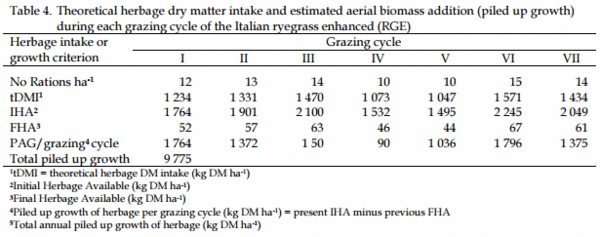
Throughout the experimental period, the estimated DM energy density of the RGE was higher and more persistent than expected (12.05 ± 0.1 vs. 7.74 ± 0.4 MJ ME kg-1 DM) (Magaz, 2004). Along with an underestimation of the DM consumption this explains at least in part, the difference between the observed and estimated number of rations (Table 3). Since the common procedure to estimate pasture DMI does not account for losses of herbage due to trampling, feces, urine, etc., and assumes that the missing biomass (IHA - FHA) represents the pasture DMI, such missing biomass was adjusted for as a percentage of losses due to fecal accumulation damage caused by transit of the mixer machine and for a quantity of TMR lost on the ground. Such losses increased steadily as the experiment progressed. Thus, the estimated pasture DMI was 90% of the disappeared biomass between the 1st and 4th grazing cycles and 85% between the 5th and 7th cycles.
In forage budgeting the lack of considering losses in the consumption of supplements affects estimation of total DM and thus on the IHA. Therefore, the indirect methodology of ration calculation did not assess correctly the herbage production of RGE. Table 5 shows the observed and estimated DM consumption of RGE, corrected for losses observed in using the TMR supplementation. Those losses were not quantified; instead, use was made of data of Bermejo (2003, not published) who found a relationship between the amount of corn silage supplied under electrified wire and losses. In this way, it was estimated that wastage losses for this feeding system could have been on average 21.3, 28.2, and 13% of the amount of supplement offered in the grazing cycles 1st to 2nd, 3rd to 5th and 6th to 7th respectively. The observed DMI per grazing cycle tended to increase as the season progress following a pattern corresponding to herbage growth (Figure 3).
Conclusions
The hypothesis that the indirect methodology of ration calculation does not accurately assess the cumulative herbage DM production resulting from grassland enhancement must be accepted.
The rejected methodology does not reflect the actual contribution of forage DM from the RGE, thus understating its real potential, which is possibly due to not taking into account the daily herbage growth rate
The technology of enhancing natural grasslands effectively improved biomass production and quality of tame ryegrass (RGE) to be used in the winter period.
Implications
In intensive livestock production systems where grasses are a key part of the diet, it is important to count on reliable, realistic methods of budgeting herbage DM. While in the long and medium term planning is usually based on estimates, objective measures are a must in the short term. This requires keeping an accurate daily record of DM production and consumption of pastoral resources, which enables making more precise adjustments of supplement offerings, resulting in greater economic efficiency.
Results of this study reflect the interaction of a number of complex factors, among which operator experience is a significant one. The nine-year implementation of this technique, constituted a learning process that generated a steady improvement in its use. Understanding of the critical management points is essential. The minimum non-grazing time to ensure formation of the required quantity of seeds to achieve adequate herbage production in the coming season, needs further research.
Considering the input dependence of this technology it is important to study optimization of herbicide and fertilizer use and to develop simulation models to make the technique more predictive and profitable.
From the biodiversity standpoint, enhancement of natural grasslands could be questioned. The overall convenience of systematic application of nonselective herbicides (E class) should be contrasted against use of contact herbicides or enhancement by more natural grazing management strategies.
Acknowledgments
This work was partially funded by Monsanto Argentina S.A.I.C., which provided two scholarships to support the research presented herein. The authors thank Altos de Casares S.A. for providing animals and facilities, and for assistance in performing laboratory analyses.
This article was originally published in Archivos Latinoamericanos de Producción Animal. Vol. 21, Núm. 1: 37-47. ISSN 1022-1301. 2013.
Literature Cited
AFRC-1993. Energy and Protein Requirements of Ruminants. Agricultural and Food Research Council. CAB International, Wallingford, UK. Agnusdei, M. G., M. R. Colabelli, y R. C. Fernández Grecco. 2001. Crecimiento estacional de forraje de pasturas y pastizales naturales para el sudeste bonaerense. Boletín Técnico N°152.31 p.
Agnusdei, M. G., A. Mazzanti, M. R. Colabelli y M. Labreveux. 1998. Fundamentos para el manejo del pastoreo de pastizales y pasturas cultivadas de la Pampa Húmeda bonaerense. (INTA, Balcarce) Boletín Técnico N°147. 16 p.
Baylor, J. E., 2002. Satisfying the nutritional requirements of grass-legume mixtures. Clemson University Extension. http://hubcap.clemson.edu/~blpprt/pdf/pasture.pdf
Casal, J. J. 2000. Foto morfogénesis: la luz como factor regulador del crecimiento. En: M. Talón y J. Azcón), Fundamentos en fisiología vegetal (Eds.) Ediciones Universitat de Barcelona, Barcelona, pp 377-388.
Cocimano, M. A. Lange y A. Menvielle. 1975. Estudio sobre equivalencias ganaderas. Producción Animal, Bs. As., Argentina, 4:161-190.
Danelón, J. L., C. G. Dapuente, G. Jaurena, R. Cantet y M. C. Saucede. 2001. Eficiencia de la capacitancia y altura de canopeo comprimido (disco) para estimar biomasa forrajera. Rev. Fac. Agron. 21 (3): 213-219.
Danelón, J. L., H. Magaz, S. Magaz, C. Llamosas y M. Wawrzkiewicz. 2005. Rejuvenecimiento de raigrás anual (Lolium multiflorum L.) en un Sistema Lechero de la Cuenca del Río Salado. XXXIIIª Reunión Asoc. Mex. Prod. Anim. Publicado en CD-ROM, Tomo II, p.583-585.
Deregibus, V. A. y M. A. Cahuepé. 1983. Pastizales naturales de la Depresión del Salado: utilización basada en conceptos ecológicos. Rev. Invest. Agropec. INTA. Vol XVIII, Nº 1. Echeverría, H. E. y R. Bergonzi. 1995. Estimación de la mineralización de nitrógeno en suelos del sudeste bonaerense. Boletín Técnico N°135. SAGyP. INTA. CERBAS. EEABalcarce. Fernández Grecco, R. C. 2000. Promoción de raigrás anual en un pastizal natural de la Pampa Deprimida bonaerense. Rev. Arg. Prod. Anim. 20 (Supl. 1): 165-167.
Fernández Grecco, R. C. 2001. Efecto de la fertilización nitrogenada invernal sobre la acumulación de forraje de un pastizal natural de la Pampa Deprimida, Argentina. Agric. Técnica, Chile. 61 (3): 319-325.
García, F. O., M. L. Ruffo, y I. C. Devedere. 1999. Fertilización de pasturas y verdeos. Informaciones Agronómicas del Cono Sur N°1. Haynes, R. J. 1980. Competitive aspects of the grasslegume association. Adv. Agron. 33: 227-261.
Hidalgo, L. G., M. A. Cauhepe y A. N. Erni. 1998. Digestibilidad de la materia seca y contenido de proteína bruta en especies de pastizal de la Pampa Deprimida, Argentina. Invest. Agr. Prod. Sanid. Anim. 13 (1,2 y 3).
Jacobo, E. J., A. M. Rodríguez, J. I. Rossi, L. P. Salgado, V. A. and Deregibus. 2000. Rotational stocking and production of Italian ryegrass on Argentinean rangelands. J. Range Manag. 53 (5): 483-488.
Jaurena, G. y J. L. Danelón. 2001. Tabla de Composición de alimentos para rumiantes de la Región Pampeana Argentina. Ed. Hemisferio Sur. 62 pp.
Magaz, H. M., 2004. Promoción de raigrás anual (Lolium multiflorum L.) en un sistema de la Cuenca del Salado. II. Evaluación de la calidad y consumo de forraje en vacas lecheras en pastoreo. Tesis de Grado. Facultad de Agronomía-UBA. 71 pp.
Malossini, F., S. Bovolenta, E. Piasentier, C. Piras, and F. Martillotti. 1996. Comparison of nalkanes and chromium oxide methods for estimating herbage intake by grazing dairy cows. Anim. Feed Sci. Tech. 61: 155-165.
Marino, M. A., A. Mazzanti y H. E. Echeverría. 1995. Fertilización nitrogenada de cultivos forrajeros anuales de invierno en el sudeste bonaerense. In Memorias XIV Reunión ALPA 19º Congreso AAPA. Mar del Plata p. 182-185.
Meijs, J. A. C. 1981. Herbage intake by grazing dairy cows. Doctoral Thesis. Agric. Res. Rep. 909. Centre. Agric. Publ. and Documents. Wageningen, Netherlands. National Research Council 2001. Nutrient requirements of dairy cattle. (7th. Rev. Ed.) National Academy of Science. Washington, D.C. 381 p.
Oesterheld, M. and O. E. Sala. 1990. Effects of grazing on seedling establishment: the role of seed and safe-site availability. J. Veg. Sci. I: 353-358.
Oesterheld, M., O. Sala, and S. McNaughton. 1992. Effect of animal husbandry on herbivorecarrying capacity at a regional scale. Natura 356:234-236. Oesterheld, M. y O. Sala. 1994. Modelos ecológicos tradicionales y actuales para interpretar la diná- mica de la vegetación. El caso del pastizal de la Pampa Deprimida. Rev. Arg. Prod. Anim. 14:9- 14.
Rodríguez, A. M., E. J. Jacobo, and V. A. Deregibus. 1998. Germination behaviour of Italian ryegrass in flooding pampa rangelands. Seed Sci. Res. 8, 521-528.
Rosso, R., J. L. Danelón y J. J. Grigera Naón. 1995. Revisión y actualización de la Unidad Vaca. Rev. Arg. Prod. Anim. 15(Supl. 2): 449-452.
Sala, O., V.A. Deregibus, T. Schlichter, and H. Alippe. 1981. Productivity dynamics of a native temperate grassland in Argentina. J. Range Manag. 34:48-51.
Sengul, S. 2003. Performance of some forage grasses or legumes and their mixtures under dry land conditions. Europ. J. Agron. 19:401-409
Singh, J. H., W. K. Lauenroth, and R. K. Steinhorst. 1975. Review and assessment of various techniques for estimating net aerial primary production in grasslands from harvest data. Bot. Rev. 41: 181-232.
Smit, H. J., H. Z. Taweel, B. M. Tas, S. Tamminga, and A. Elgersma. 2005. Comparison of techniques for estimating herbage intake of grazing dairy cows. J. Dairy Sci. 88 (5):1827- 1836. SMN. 2008. Servicio Meteorológico Nacional. Disponible en: http://www.smn.gov.ar/
Stuth, J. W., W. T. Hamilton, J. C. Conner, D. P. Sheehy, and M. J. Baker. 1993. Decision support systems in the transfer of grassland technology. In: M. G. Baker (Ed.) Grasslands for Our World. Sir Publishing Co. Wellington. pp. 234- 242.
Tommasone, F. y J. García Oliver. 1999. El impacto de la siembra directa y de los rejuvenecimientos en empresas ganaderas de la Argentina. Difusión Ganadera, pp. 133-160.


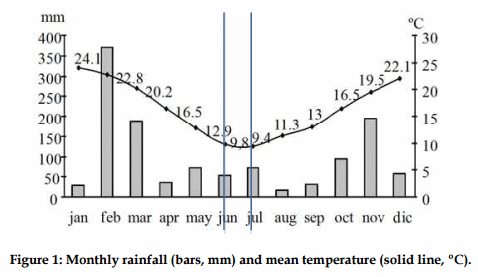
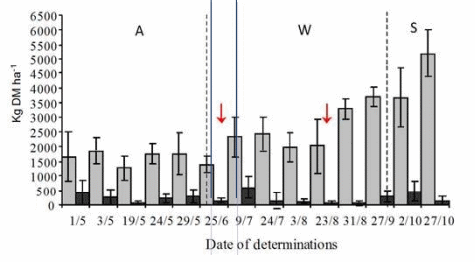
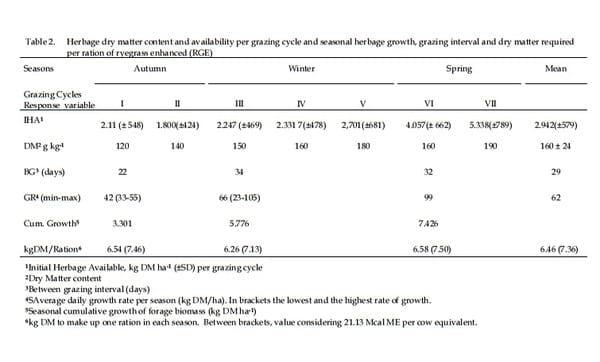

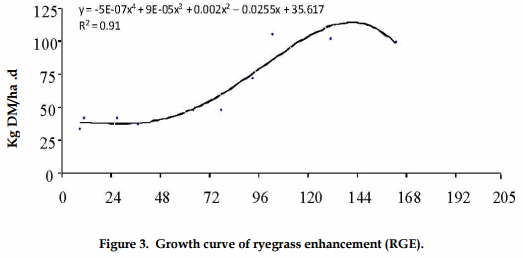




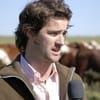






.jpg&w=3840&q=75)